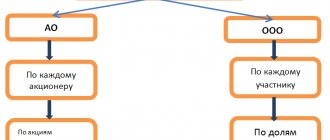Recording transactions on accounts
In accounting, all business transactions are recorded in the form of accounting entries using special created accounts, each of which is assigned a unique number.
Basic accounting procedures (examples) can be found here.
Similar transactions are grouped in separate accounts. The name of the account directly indicates the specifics of the transaction reflected on it.
All changes that directly occur with economic assets and their sources lead to their change in monetary terms.
The list of accounts officially approved in the Russian Federation - Chart of Accounts (Order of the Ministry of Finance dated October 31, 2000 No. 94n) is suitable for use in any industry.
For example, an accountant of a furniture factory will take into account lumber and furniture fittings on account 10 “Materials”, an accountant of a legal consultation will take into account pens and paper, etc.
In practice, enterprises use only accounts that correspond to the specifics of the type of activity in which they are engaged. The accounts used by the enterprise constitute the Working Chart of Accounts of the enterprise, which in turn is an integral part of the Accounting Policy.
Read about the applicable accounts in 2021 - 2021 in this material.
The account has a tabular form: the left side is called “debit”, the right side is called “credit”.
To indicate the balance of an account either at the beginning or at the end of a period, the term “balance” exists.
Accounting accounts are either active or passive. The accounts on the sides of the balance sheet are named and correspond to their contents.
The structure of the accounts is similar (both active and passive accounts have sides called “debit” and “credit”), but the meaning of these sides is different - it is important to remember this.
N.N. Tomilo, 3rd Class Advisor to the State Civil Service of the Russian Federation, in his consultation explained the differences between active and passive accounts. Study the opinion of the official in ConsultantPlus. If you do not have access to the system, get a trial demo access for free.
Accounting accounts, their purpose and structure
In order to register business transactions in monetary terms, an enterprise uses a certain instrument when carrying out business activities.
This instrument in accounting is accounts. An accounting account is a system of interconnected reflection and grouping of an enterprise’s property by composition and location, as well as by the sources of its formation, expressed in monetary, natural and labor measures. Schematically, an account is a T-shaped table in which the left side is a debit and the right side is a credit.
| Dt (Debit) | Kt (Credit) | ||
For certain groups of property and the sources of its formation, separate accounts are used, which reflect the balance at the beginning of the accounting period (opening balance), and record all changes caused by ongoing business transactions. As stated earlier, every account has two sides: debit and credit. The movement of business transactions on the left side (debit of the account) is called debit turnover; on the right side (account credit) - credit turnover. At the end of the accounting period, the balance at the end of the accounting period (closing balance) is formed for each account by comparing the opening balance, debit and credit turnover. The final account balance subsequently serves as the basis for the formation of a balance sheet.
All accounting accounts are fixed in the chart of accounts and each of them is designed to account for certain types of funds and sources.
The account reflects:
a) Availability of property or sources at the beginning of the accounting period (for example, the debit balance on the “Cash” account as of September 1 is 800 rubles).
b) Turnover (by debit and credit) - the amount of transactions for the reporting period (for example, 700 rubles received at the cash desk for September - debit turnover; issued from the cash register for September 500 - credit turnover).
c) The balance of property or sources at the end of the accounting period (for example, the debit balance on the “Cash” account as of September 30 is 1,000 rubles).
Accounting accounts are divided into:
- active
- passive
- active-passive
Active accounts
Active accounts are those that are used to record information about the property of the enterprise. For example: money, including in foreign currency, transfers in transit, own shares.
An increase in funds in an active account is reflected as a debit, and a decrease as a credit. At the end of the period, the balance of the active account is debit.
Active accounts include: , , 04, 07, 08, 09, , 11, , , 21, 23, 25, , , 29, , , 44, 45, 46, , , 52, 55, 57, 58, 81, , 97.
Example
Shtrabak LLC purchased a laptop. The cost of the laptop is 87,000 rubles. without VAT. The debit of account 01 “Fixed assets” has an opening balance of 0 rubles. The accountant reflected the acceptance of the laptop as a debit, since the account used is active. The final debit balance is RUB 87,000.
Accounts active and passive
Active accounts
Active accounts are accounts that reflect information about the balances and movement of funds (in cash equivalent, in bank accounts) and property (in warehouse, in operation) that are at the disposal of the organization. For example, account 50 “Cash”, 01 “Fixed assets”, 10 “Materials”, etc.
| Dt (Debit) | Kt (Credit) | ||
| Opening balance | |||
| Admission (+) | Disposal (-) | ||
| Turnover | Turnover | ||
| Closing balance | |||
The ending balance on the Active account is equal to the opening balance + debit turnover – credit turnover.
Example: For account 50 “Cashier” as of September 30, 2017. 800 rubles.
During the day the following business transactions occurred.
Money arrived at the cash register:
- From the current account RUB 30,000;
- For sold milk 2,400 rubles;
- Rent 650 rubles;
- Revenue from the canteen 980 rubles;
Issued from the cash register:
- Salary 24,000 rubles;
- Alimony 2,300 rubles;
- Accountable amount 6,170 rub.
Determine the balance as of October 1.
| Dt (Debit) | 50 "Cashier" | Kt (Credit) | |
| Balance as of September 30, 2017 800 rub. | |||
| 1) 30 000 2) 2 400 3) 650 4) 980 | 5) 24 000 6) 2 300 7) 6 170 | ||
| Turnover 34,030 | Turnover 32,470 | ||
| Balance as of October 1, 2017 2 360 | |||
Passive accounts
Passive accounts are accounts designed to account for certain types of sources (capital, retained earnings, liabilities of the organization). For example, account 66 “Settlements for short-term loans and borrowings”, 80 “Authorized capital”, 84 profit, etc.)
| Dt (Debit) | Kt (Credit) | ||
| Opening balance | |||
| Decrease (-) | Magnification (+) | ||
| Turnover | Turnover | ||
| Closing balance | |||
The ending balance on the Passive account is equal to the initial loan balance + credit turnover – debit turnover.
Example: Balance as of September 1, 2021 on account 66 “Settlements for short-term loans and borrowings” 40,000 rubles.
The following business transactions occurred in September:
- Received a loan to the current account of 68,000 rubles
- Transferred to the supplier of raw materials through a short-term loan of 62,000 rubles.
- 28,000 rubles were transferred to the oil depot using a short-term loan.
- The loan from the current account was repaid for RUB 42,000.
Determine the balance as of October 1.
| Dt (Debit) | 66 “Settlements for short-term loans and borrowings” | Kt (Credit) | |
| Balance as of 09/01/2017 RUB 40,000. | |||
| 4) 42 000 | 1) 68 000 2) 62 000 3) 28 000 | ||
| Turnover 42,000 | Turnover 158,000 | ||
| Balance as of October 1, 2017 156 000 | |||
Passive accounts
Passive accounts are those that demonstrate methods of forming property (loans provided, contributions from participants, etc.).
An increase in funds is reflected as a credit, a decrease - as a debit. At the end of the reporting period, the balance of the passive account is credit.
The following accounts are considered passive: 02, 05, 42, 59, 63, 66, 67, 70, 77, , 82, 83, 96, 98.
Example
The only participant in Shtrabak LLC was granted a loan. Loan in the amount of 150,000 rubles. arrived at the bank account of Shtrabak LLC.
Shtrabak LLC keeps records of settlements for short-term loans on account 66. The initial credit balance on this account is 0 rubles.
The accountant reflected the receipt of 150,000 on the loan, since the account is passive. Loan turnover—RUB 150,000.
In less than a month, 50,000 rubles. were returned to the lender. The accountant completed the posting, and an entry appeared in the debit of account 66 - 50,000 rubles. The total turnover on the debit of the account is 50,000 rubles.
The final credit balance is RUB 100,000.
Example of passive accounts in an NPO
Passive account 02 “Accrued depreciation” has a credit balance on the account. Turnover in the debit of the account reflects the write-off of accrued depreciation upon disposal of fixed assets.
The following example: passive account 70 “Settlements with personnel for wages”. The credit of the passive account reflects the accrual of earnings. Debit account turnover - withholding income tax or making payments. A negative account balance is a declaration of an erroneous account.
Balance sheet
The debit balances make up the left side of the balance sheet - the asset, and the credit balances make up the right side of the balance sheet - the liability. The balance sheet total (of each section) is called its currency.
Information about the financial condition of an enterprise in rubles as of a certain date can be obtained through the balance sheet, as well as information about the nature and size of the property.
Information in the balance sheet is grouped into sections, and sections consist of items. Balance is a Latin word and translates to “two cups.” Maintaining equality between assets and liabilities is the main principle of balance.
The sum of all balance sheet asset items (indicators characterizing the organization's economic assets) is equal to the sum of all balance sheet liability items (indicators characterizing the sources of economic assets).
Balance sheet data is used to control the amount of economic assets, their structure, sources, analyze the financial condition of the organization, and its solvency. The main form of accounting reporting, which is provided to regulatory authorities and interested users (banks, counterparties), is the balance sheet.
For more information about reporting forms, see the section “Accounting statements of the organization.”
Purpose and concept of an active account
Definition 1
An accounting account is the most important element of the accounting method, designed to keep records of a homogeneous group of objects through double entry.
Depending on the structure (relationship with the balance sheet), accounts are divided into three groups: active, passive and active-passive.
Definition 2
An active account is an account designed to keep records of various types of property of an organization, its availability, composition, and movement.
Passive Accounts
Subscribe to our YouTube channel!
In the article “Active Accounting Accounts” I told you about the concept of an accounting account and, in general, about accounting in general. We also discussed in detail the scheme and structure of the active account.
This article is entirely devoted to passive accounting accounts.
So, a passive account is a plate consisting of:
the balance at the beginning
(
arrow 1
) - this is the account balance at the beginning of the period, the left part of the plate called
Debit
(
arrow 2
), the right part of the plate -
Credit
(
arrow 3
), and
the balance final
(
arrow 4
) - balance at the end of the period.
Debit turnover
is the sum of all entries in the debit of the account (
arrow 5
).
Loan turnover
is the sum of all entries in the account loan (
arrow 6
). As you already understand, the composition of the passive account is absolutely identical to the active account.
What's the difference? The difference is in the principle of their work
Passive account operation scheme
As you probably remember, in the article “Active Accounting Accounts” I wrote about the movement that occurs on active accounting accounts - about increasing and decreasing the account. So, the same thing happens on passive accounts, but exactly the opposite!
Let's look at the sign:
Because
passive accounts
serve to record the sources of property formation, as well as to reflect the company’s debt to third parties, then the increase in such liabilities is recorded on
the credit of the account
(
arrow 1
).
Consequently, the repayment of the company’s debt, that is, the reduction of liabilities, is recorded as the debit of the account
(
arrow 2
).
As can be seen from the formula, in order to obtain the final balance of a passive account, you should add the initial balance with the loan turnover and subtract the debit turnover.
The passive account has only a credit balance.
Examples of how a passive account works.
As an example, we use account 67 “Settlements for long-term loans and credits”
, namely:
The company took out a bank loan in the amount of RUB 120,000
.
Then the loan was partially repaid in the amount of RUB
40,000 . Let's calculate the final balance, i.e. the balance of our debt at the end of the analyzed period.
At the beginning of the period, the organization had no debt on long-term loans. This means that the entry at the beginning of the period will be like this ( arrow 1
).
The organization received a loan in the amount of RUB 120,000
., it turns out that she has accumulated a debt to the bank, in other words, there has been an increase in the passive account, which we record in
CT account 67
(
arrow 2
).
When the loan is partially repaid, the organization's debt decreases; we show this movement in Dt account 67
(
arrow 3
).
Now we move on to calculating the loan debt at the end of the reporting period, for this, according to the above formula, we substitute the values: To summarize:
as we see, at the end of the reporting period, the company’s debt to the bank (or it is called accounts payable) amounted to
80,000 rubles
. as evidenced by the entry on
Ktch.67
.
Read how active accounting accounts work here.
You can learn how to make transactions by reading the article “Account. Double entry."
In order to accurately and confidently conduct accounting from “0” to the balance sheet, I would recommend taking a unique course for beginning accountants “Accounting and Taxation for Beginners +1C 8.3” in full-time or remote form, which will help not only to master all the basics of accounting, but and learn to calculate taxes, generate reports and confidently master the 1C program. See how the practical exercises work in this course.
Take the test to see how much you have mastered the material:
A decrease in the organization’s obligations to third parties is reflected:
— by Debit of an active account —
by Debit of a passive account
— by Credit of a passive account
Passive account balance:
—
Credit only
— Debit only — can be both Debit and Credit
Passive accounts are used to account for:
— property (funds) of the organization —
sources of formation of property.
| Author of the article: Tatyana Valerievna Matasova - expert on tax and accounting issues |
Definition and purpose of passive accounts
Definition 2
Passive accounts are accounting accounts whose purpose is to record the movement, status, and changes in the amount of sources of funds of the enterprise.
Passive accounts reflect transactions during which the amount of funds (assets of the enterprise) changes, as well as types of transactions that can change the composition of the enterprise's debts. An example of the latter is the internal movement of enterprise funds between passive accounts, as an example of the withholding of taxes from employee salaries.
Note 1
The purpose of passive accounts is to record the obligations of an enterprise to its partners, the state or employees.
Need advice on your academic work? Ask a question to the teacher and get an answer in 15 minutes! Ask a Question











